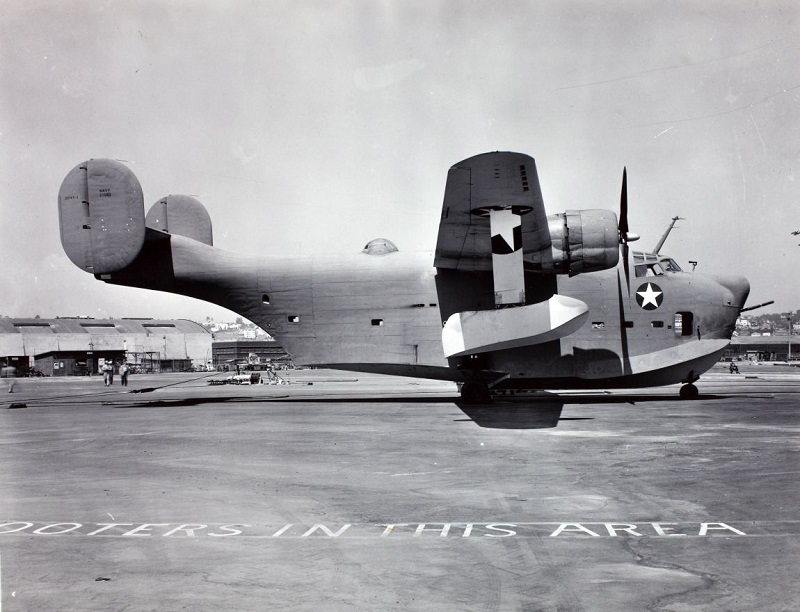
|
Consolidated (Model 31) XP4Y-1 Corregidor |
 |
||||||||
|---|---|---|---|---|---|---|---|---|---|---|
 |
 |
 |
 |
 |
 |
 |
 |
 |
 |
 |
|
In 1937 David R. Davis, a freelance aeronautical engineer, approached the Consolidated Aircraft Company with a new and revolutionary low-drag high aspect-ratio wing design. He claimed that his wing was a much more efficient design than any other wing available at the time. He was met with much skepticism by the president of Consolidated, Reuben Fleet, and his chief engineer, I. M. Laddon, because the National Advisory Committee on Aviation (NACA) had recently performed a comprehensive study on airfoil shapes. However, the NACA airfoils did not include anything similar to the Davis wing. Several days later, Laddon reconsidered that Davis could be right and Reuben Fleet agreed to pay for a model and wind tunnel tests at the California Institute of Technology (Cal Tech). The model and test cost $40,000.1 The results were so outstanding that Cal Tech ran its own tests, a second and third time, to confirm the results. Cal Tech thought it might actually be a wind tunnel fluke, but after receiving the report, Reuben Fleet decided to take a gamble and install the wing on the twin-engine Model 31 flying boat as a possible successor to the PBY Catalina.2 The Model 31 made its inaugural flight on 5 May 1939 and it left no doubt that Reuben Fleetís $1 million gamble had paid off. The test pilot, Bill Wheatley, reported that the airplane had the performance of a pursuit plane. The top speed on the test was reported at 250 mph and the range was anticipated at 3,500 miles. The Davis wing had 20% more performance than any other comparable airplane.3 By comparison, the PBY had a top speed of approximately 170 mph and a normal range of only 2,500 miles. The Model 31 had proved so successful that it was decided that the Davis wing would be incorporated into the design of the B-24 Liberator. The US Navy purchased the sole prototype and designated it as the XP4Y-1—it was later named Corregidor. Armament was added and consisted of one 37mm cannon nose turret, two .50 caliber machine guns in the tail and dorsal turrets and provision to carry 4,000 lb. bombs externally. An order for 200 aircraft was placed in October 1942, but due to design delays and a shortage of Wright Cyclone R-3350 engines (the engines were reserved for the Boeing B-29 Superfortress), the order was canceled.

Construction: The fuselage was an aluminum flush-riveted construction and had two decks with one flight compartment and eight additional compartments. The flight compartment was completely sound proof. 4 It had a cantilever straight wing with internal fuel tanks and was equipped with hydraulically controlled Fowler flaps. The flaps were fabric covered as well as the flight controls.5 The tail unit was mounted above the fuselage, with two oval shaped vertical stabilizers mounted on each side of the horizontal stabilizer. (The same tail would be used on the B-24 Liberator.) It had two retractable underwing floats and hydraulically controlled tricycle beaching gear. It was powered by two 2,000 hp Wright Cyclone R-3350 twin-row radial engines.6 It had accommodations to carry either 52 passengers or 28 for the sleeper version.

|
| Specifications: | |
|---|---|
| Consolidated (Model 31) XP4Y-1 Corregidor | |
| Dimensions: | |
| Wing span: | 110 ft 0 in (33.53 m) |
| Length: | 74 ft 1 in (22.58 m) |
| Height: | 25 ft 2 in (7.67 m) |
| Weights: | |
| Empty: | 29,324 lb. (13,306 kg) |
| Gross: | 48,000 lb. (21,772 kg) |
| Performance: | |
| Maximum Speed: | 247 mph (398 km/h) |
| Cruise: | 136 mph (219 km/h) |
| Service Ceiling: | 21,400 ft. (6,520 m) |
| Range: | 3,280 miles (5,279 km) |
| Powerplant: | |
| Two Wright Cyclone R-3350 2,000 hp (1,491 kW) 18 cylinder radial engines. | |
| Armament: | |
|
One 37mm cannon nose turret, Two .50 caliber machine guns in tail and dorsal turrets, Provision to carry 4,000 lb. bombs externally. | |
Endnotes:
|
1. William Wagner. Reuben Fleet and the Story of Consolidated Aircraft. Fallbrook, California: Aero Publishers, Inc., 1976. 206. 2. Allan G. Blue. The B-24 Liberator, A Pictorial History. New York: Charles Scribner's Sons, 1975. 11. 3. William Wagner.206. 4. Glenn D. Angle, ed. Aerosphere 1941. New York: Aircraft Publications, 1941. A-32. 5. David Mondey. The Concise Guide to American Aircraft of World War II. New York: Smithmark Publishers, 1982. 66. 6. Howard Mingos, ed. The Aircraft Year Book for 1940. New York: Aeronautical Chamber of Commerce of America, Inc., 1940. 220. |
Return To Aircraft Index.
©Larry Dwyer. The Aviation History Online Museum.
All rights reserved.
Created September 27, 2013. Updated January 22, 2023.